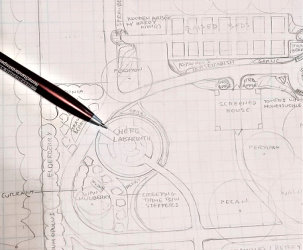As the snow begins to melt and spring bulbs are starting to pop-up, our excitement for warmer weather can hardly be contained. The snow melting also exposes all the dormant plant material that’s been covered so long. Don’t feel overwhelmed if you see a landscaping mess. With a few simple steps you can do some clean up and start your garden off on the right foot to flourish this season.
Depending on the weather of the previous fall, we can sometimes have a lot of clean up finished, and sometimes we aren’t able to clean up any leaves before the snow settles in. The first step in spring cleaning your landscape is to remove the leaves that have been buried under the snow. These tree leaves are often wet and sticky and as they start to decompose they can introduce unwanted insects and disease to the new perennials growing underneath. Leaves on the turf can also introduce fungus and disease to your lawn if they are too thick and block sunlight or trap moisture. Removing leaf debris to compost elsewhere, then reapplying the broken down compost into the garden beds is the best way to keep all those nutrients in your yard while limiting the chance of disease.
After you have removed the tree leaves from the landscape, it is much easier to see what you are working with. If you have any perennials that didn’t get cut back in the fall, now is the time to remove the dead leaves and stalks. Herbaceous perennials die back to the ground each winter and they grow new stems and leaves after their dormancy period. Some perennials have a “crown” that you do not want to damage. The crown is the where the new leaves grow from the base of the plant. By leaving 2-3” when you cut back the perennial you can avoid harming the crown and you remove the bulk of the leaf to remove the litter.
Grasses are commonly left alone in the fall because they can add color and texture to the winter landscape. Leaving the blades in tact can also help protect the crown of the grass through the winter. It is ultimately up to the owner whether grasses get cut back in the fall or spring. If you’ve left your grasses tall through winter, spring is the time to give them a haircut. The size and maturity of your grass will determine the best tool for the job. Large grasses such as Zebra grass and mature Karl Foersters are easiest to cut with power-hedgers, or manual shears with a long blade. Small grasses can be cut with simple hand pruners. When cutting back grasses you want to leave about 6” above the ground to make sure you do not cause stress to the crown of the plant.
It is best to avoid pruning roses in the spring. Roses can be sensitive in our zone and there is commonly winter die-back along the stems of roses. If you cut your roses in fall, the die-back could go far enough to kill large stems, or whole sections of the rose. When you trim your roses in the spring, the first step is to cut out dead branches and to cut any canes with die-back; the dead wood will be a different color than the live, green branches. Any branches you shorten, you want to make sure the next bud left on the stalk is facing away from the center of the plant. You will also want to cut any branches that are rubbing against each other, or look like they will cross soon. If you have any specific questions about pruning your roses, feel free to email us or stop into the store.
A top dressing of mulch is the finishing touch on a landscape. When your plants are all cut back and you have everything cleaned to the best of your ability, it is smart to apply a granular pre-emergent first, before applying the mulch. The pre-emergent helps to keep weed seeds from germinating. This will not help against weeds that are already established in the landscape, so pull what you can if any weeds are already present. Once the granules are spread in the landscape beds, you can apply a thin layer of mulch across the top; this helps to hold the pre-emergent in place for the most effective coverage. It is also important to note that you should avoid digging in or disturbing the areas once the pre-emergent has been watered in. Once you have evened out the mulch you can step back and enjoy the beautiful view. There may not be many plants that have fully broken dormancy and you may not see many leaves, but your landscape is refreshed and ready for the season ahead.
If you are unable to clean your own landscape, or if you do not have the time we can complete a thorough clean-up for you. Come into the shop, or give us a call to get on the schedule. You will be amazed what some spring-cleaning can do to change your yard.








